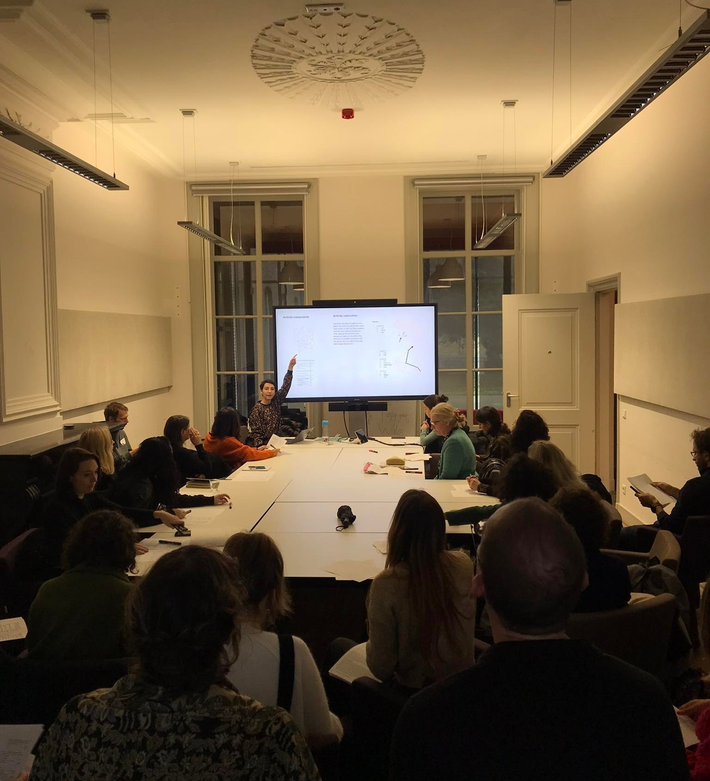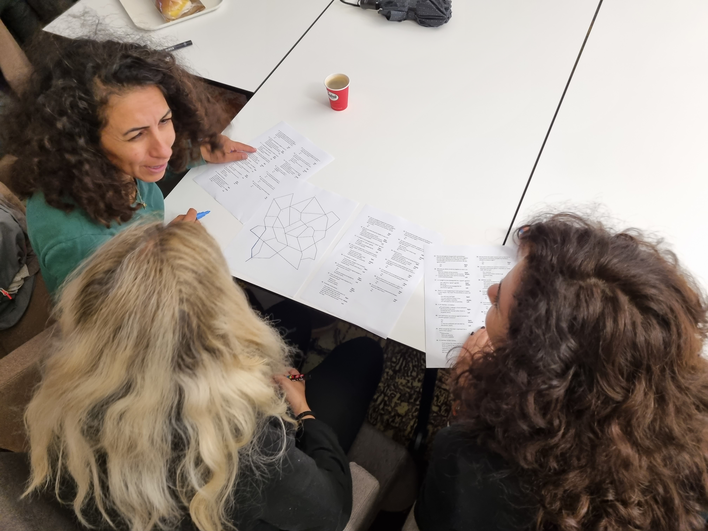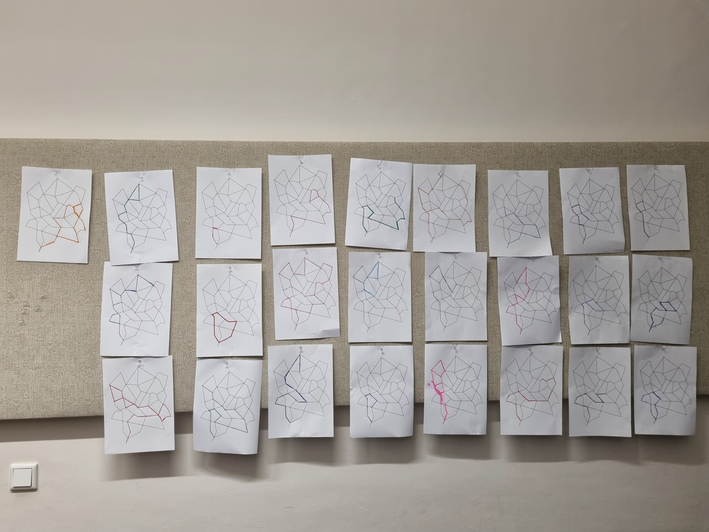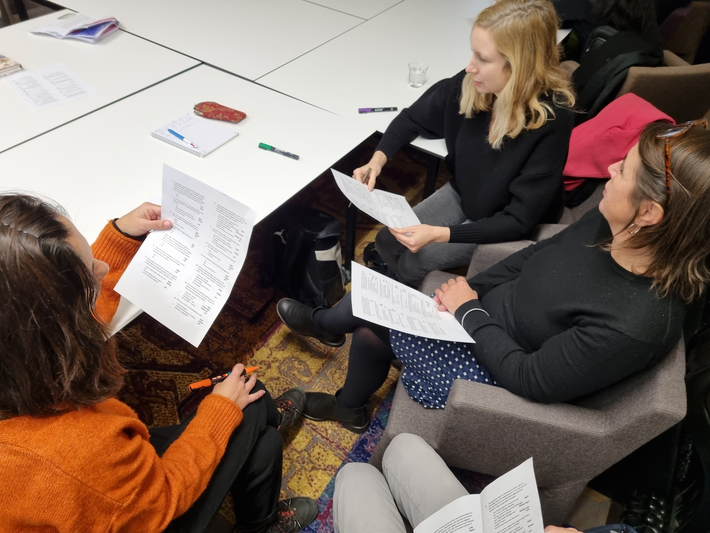Footnotes:
1 This highlights a common issue found in socially-engaged art projects that solely prioritize participants' agency in addressing socio-political issues and/or assume responsibility for their own/community's social/political/etc development. Such projects often operate akin to charity, deflecting responsibility from the state/structure/system in their discourse. Instead, they emphasize the collaborative care and agency shared between individuals and communities for societal repair.
2 The cosmopolitan liberal idea of agency, as opposed to the communitarian one, relies on the idea that agents have preferences and identities formed prior to social interaction. It suggests that any social attachments they have are freely chosen rather than constitutive in any way.
3 L., Rogoff, Sonic Acts Festival. "Hereafter." Presentation at De Brakke Grond, Amsterdam, The Netherlands, February 22, 2019. <https://youtu.be/D3AcgQoGaSU> (accessed May 2023)
4 F., Hübner, “In Good Company. Think We Must.” Fontys Fine and Performing Arts, 2022.
5 This is deliberately mentioned in connection with Chantal Mouffe's definitions of antagonism and agonism: Laclau and Mouffe argue that a fully-functioning democratic society is not one in which all antagonisms have disappeared, but one in which new political frontiers are constantly being drawn and brought into debate—in other words, democratic society is one in which relations of conflict are sustained, not erased (Bishop, “Antagonism and Relational Aesthetics,” p. 65.). Agonism is a ‘we/them’ relation where the conflicting parties, although acknowledging that there is no rational solution to their conflict, nevertheless recognize the legitimacy of their opponents (Chantal Mouffe, keynote presentation at the “Cork Caucus” event in 2005. Published in Cork Caucus: On Art, Possibility and Democracy, (Cork, Ireland: National Sculpture Factory, 2005), p.153.). Furthermore, Oliver Marchart offers an intriguing response to Mouffe's ideas, arguing that antagonism plays a crucial role in political activism and conflictual aesthetics (O. Marchant: Conflictual Aesthetic: Artistic Activism and the Public Sphere, 2019), making it a valuable source for further exploration.
6 S. Bara, The Gestures of Participatory Art, Manchester University Press, 2018, p. 23
7 C. Bishop, Installation Art: A Critical History, London, Tate Publ, 2011, p.11.
— You, Me, They; The Participants
Participation as a medium in artistic practices holds the promise of providing new kinds of engagement for participants and spectators. It transcends the traditional one-to-one relationship between the artwork and the viewer, fostering an environment where the public can actively contribute as co-creators of unfolding events. Even further, as Sruti Bala says, the viewer is not necessarily required to participate or enter the installation, but simply spectating is already a form of engagement: “Sort of participation without belonging —taking part in without being part of.”6
In participatory installations with a specific socio-political approach, especially those that demand some type of activation or participation, Merleau-Ponty’s series of negotiations with the environment can be developed into discussions, arguments and conversations between spectators. This level of engagement renders the participants co-creators, not merely spectators. Bishop’s research on recent critics and artists writings on participatory installations, emphasizes the political and ethical implications of the viewer's active presence when compared to engagement with traditional art; “a transitive relationship is implied between activated spectatorship and active engagement in the wider social and political arena.”7
However, the ethical concerns of moving between the heteronomy and autonomy of agents by giving or taking the power of decision-making to and from participants is still debated (Bishop, 2012; Albu and Schuld, 2018; Bala 2018). Cultural production and cultural consumption have become established subjects of sociological and political scholarship over the past decades (Hafsteinsdóttir, 2015; Inglis and Hughson, 2005) but the question of how artistic forms, modes, curatorial strategies and ethical considerations within participatory-based artistic practice can deepen the political conversation for or by participants and non-participants is still unresolved. This is particularly significant in the context of the rise of the state's cultural participation agenda, as previously mentioned.
Due to the inherent characteristics of temporality and context/site specificity, participatory and socially engaged art practices have often been encountered through documentation rather than through firsthand experiences. This limited exposure, combined with a lack of contextual knowledge, has hindered our ability to provide adequate criticism for such artworks. By primarily interpreting them as social or political art pieces, or works that engage with the public and communities, we have inadvertently overlooked certain ethical and social problematics that may arise. The ethics of participation entail a set of moral considerations that direct individuals' engagement across diverse activities. These considerations encompass several key principles, including informed consent, voluntary participation, respect for autonomy, equity and inclusion, beneficence, transparency and accountability, fairness and justice, and collaboration and co-creation.
In considering these aspects, it's crucial to approach participatory art with a nuanced understanding of ethical responsibilities. This reflection invites readers to explore how these principles manifest in practice, prompting a deeper engagement with the ethical dimensions of participatory art.
— Thinking aloud about my take on artistic connectivity
The methodological objectives of “An Experiment on Agency” may seem ambitious and somewhat utopian for artistic research. However, it is crucial to acknowledge that the aforementioned artistic methodologies in themselves serve as intricate probes, facilitating the exploration and practice of new relationships within this deeply charged theoretical subject. These methodologies embody what Irit Rogoff identifies as "becoming research," a notion that emphasizes the dynamic and transformative nature of the research process. As Rogoff describes it, "research as an event of itself has migrated to creative practices. What has become less and less feasible within research environments, such as universities and research institutions, has been taken on and developed in different ways within creative practices, offering us the process of becoming and a new mode of relations and knowledge. [...] this theory-practice realm entails to move from inherited knowledge to conditions."3 In this shift, emphasis is on a more dynamic, contextually grounded, and responsive form of research that actively engages with the conditions shaping the (art)world, instead of relying solely on pre-existing knowledge (such as traditions, established theories, historical perspectives). If we embrace this evolving research paradigm, then the questions of "why" and "how" become pivotal in our exploration and extend beyond the boundaries of this exposition. It is through engaging with these questions and embracing the process of "becoming research" that I believe we can bridge the gap between practice and theory.
Within this context, I find resonance with the concept of Artistic Connective Practices, which serves as a "theory-practice" framework for exploring questions, issues, and nodes of concern and interest within specific socio-political, geographical, communal, intellectual, and other pertinent realities. However, I am compelled to revisit Irit Rogoff's notion of "complexity." By incorporating this notion into our understanding of Artistic Connective Practices, we can resist the tendency to adopt a neoliberal perspective that oversimplifies complex realities: through the integration of dynamic, contextualized, and conditional experiences in our research, we challenge the dominance of positivism and top-down perspectives that tend to simplify our conditional reality.
In this regard, an intriguing and persistently challenging aspect of these practices lies in the exploration of the common and the mutual. In their essay titled "In Good Company. Think We must," Falk Hübner and colleagues engage in a discourse on mutuality, they argue that: “This does not necessarily imply an equal relationship, however (in conversation with Heleen de Hoon:), but rather one of “resonance”, which sociologist and philosopher Hartmut Rosa frames as ‘a form of world-relation, in which subject and world meet and transform each other’ (Rosa 2016, 298, translation by Susen 2020).”4 While I agree with these points, a question continues to arise: to what extent can we embrace antagonism when we "meet" within these artistic connective practices? This inquiry probes the boundaries and possibilities of engagement, even if it is antagonistic, inviting further exploration into the complex dynamics at play.5
An Experiment on Agency #7
Connective Symposium, Fontys University of the Arts Tilburg
Reyhaneh Mirjahani
In numerous geographical contexts across the globe, individuals living under imperialism, neoliberalism and/or ideological dictatorship are faced with difficult and complex socio-political situations that make it challenging to exercise their agency. The complex network of economic and socio-political conditions intertwined with the constructs of race, gender, and (dis)ability within these contexts, compels individuals and communities to navigate, embody, and negotiate their political agency on a daily basis. "An Experiment on Agency" is an ongoing research-based and participatory artistic project on which I have been working for the past three years. The project is centered around the concept of agency within politically challenging situations characterized by dilemmas, where the actors involved find themselves in a perplexing "lose-lose" predicament (Frost, 2003). These situations leave the actor with a difficult choice between two or more undesirable alternatives based on the given context such as to choose between censorship and freedom of speech in a critical context; to lie, leave, fight, protest, ignore, believe, follow, vote.
In creating a series of participatory installations/events, the project inquires into how artistic practice can lead viewers to question, discuss and understand the existence of agency within such dilemmatic choices. The installation space aims to facilitate discussions, and to draw attention to political situations in which there is no safe choice. It aims to explore the limitations that are imposed on agency, to bring up the question: if in these situations we lose agency, what are the systems that deprive us of it, or, potentially, empower us with a new kind of agency?
Through these temporary participatory events, I invite the public to explore our imagined agency by inviting them to walk individually and/or collectively inside a floor map with branching paths. According to how they answer a series of questions along the paths, the participants each make their own route through the map. Political conflicts and relations between the oppressed and their oppressors, are presented through the questions as they are played out on the world’s stage – there are no easy answers, nor clear winners.
For the Connective Symposium, I chose to present my research in the form of a workshop instead of a participatory installation. Prior to introducing the project, I engaged other symposium participants in two different activities. In one, they formed groups of 4-5 participants, each equipped with a map, to collectively make decisions and determine a path based on the questions and answers given. In the other, participants undertook the same task individually. The results of both activities were presented on the wall after their completion.
Following this, I delivered a performative lecture presenting the project, highlighting two key aspects of the research:
- Considering the elevated emphasis on cultural and political participation in state patronage, frequently aligning with and contributing to cosmopolitan liberal ideas, how do we grasp the limitations of participatory projects while harnessing their potential? In what ways can artistic forms, modes, curatorial strategies, and ethical considerations within participatory-based practices enrich political conversations for both participants and non-participants? How can this form be further developed to contribute to political debates without absolving the state/system of its responsibility for community and social development, and instead solely placing the responsibility on participants?1
- As a facilitator who actively engages as a participant, grounding my role in this project, how do we navigate the dual identities of being both artists and facilitators?
The research project delves into the interplay between practice-based and theory-based research, aiming to explore the potential of participatory methods in bridging the gap between theory and practice. Within the subject area, there has been extensive discourse on agency, with political and social science scholars (Ainley, 2006; Barnes, 2000; Pettit, 2001; Frost, 2003) engaging in discussions on the possibility or impossibility of true agency and analyzing the impact of ethical and structural constraints on our sense of agency.
Within the realm of art, discussions on agency, responsibility, and ethics in contemporary art constitute a growing body of work. However, the intricate interplay between these concepts has not received due attention. Various types of participatory works have been made either examining the participants’ agency, often assuming it always exists (Bruguera, 2009, 2015; Mobed, 2013; Reyes, 2015) or offering shallow, singular-event based, and instrumentalized discussions on agency (Sierra, 2002; Zmijewski, 2004). Despite these efforts, there remains a gap in research examining decolonial practices emerging from these artistic experiments.
To fill this gap, this artistic research project aims to bring together dilemmatic political situations from various regions and ongoing theoretical debates on the (im)possibility of agency through a series of iterative participatory experiments and discussions. By integrating theory and practice, the research conducts explorations grounded in conversations within participatory experiments. It critically examines the challenges posed by the Western cosmopolitan liberal notion of agency2, moving beyond a binary approach and instead exploring the dynamic and ever-shifting network of relationships between agency and structure.
The ultimate objective is to establish a meaningful connection between the series of participatory experiments and theories surrounding the (im)possibility of agency. In doing so, specific participatory research methods will be developed, fostering dialogue and providing a space for examining the mechanisms involved in the (im)possibility of agency. Ethical considerations will be paramount, particularly in navigating the tensions between heteronomy and autonomy for participants and non-participants. This research will draw on debates put forth by Bishop (2012), Albu and Schuld (2018), and Bala (2018) to further explore these ethical concerns.
How is the well-being (physically, mentally and emotionally) and safety of participants prioritized throughout the project?
This taking upon ourselves the consequences for things we are entirely innocent of, is the price we pay for the fact that we live our lives not by ourselves but among our fellow men, and that the faculty of action, which, after all, is the political faculty par excellence, can be actualized only in one of the many and manifold forms of human community.
(Amor Mundi, 1987)
Wherever people gather together, it is potentially there, but only potentially, not necessarily and not forever.
(Hanna Arendt, 1998)
How do artists and organizers ensure that participants are not coerced or pressured into participating against their will?
Bibliography:
Ainley, K., ‘Rethinking Agency & Responsibility in Contemporary International Political Theory’, unpublished PhD Thesis, London School of Economics, 2006.
Albu, c. (ed.), Achuld, D. (ed.), Perception and Agency in Shared Spaces of Contemporary Art, London, Routledge, 2018.
Bala, S., The Gestures of Participatory Art, Manchester, Manchester University Press, 2018.
Barnes, B., Understanding Agency: Social Theory And Responsible Action, London, SAGE, 2000.
Bishop, C., Installation Art: A Critical History, London, Tate Publ, 2011.
Bishop, C., Artificial Hells: Participatory Art and the Politics of Spectatorship, London , Verso Books, 2012.
Bishop, C., “Participation and Spectacle: Where Are We Now?”, in: Thompson, Nato. (ed.) Living as form: Socially engaged art from 1991-2011. New York, N.Y: Creative Time. 2012.
Frost, M., ‘Tragedy, Ethics and International Relations’, International Relations, vol. 17, no.4, 2003, p. 477-95.
Hafsteinsdóttir, Elín, ‘The Art of Making Democratic Trouble: Four Art Events and Radical Democratic Theory’ (Department of Political Science, Stockholm University, 2015)
Hübner, F., “In Good Company. Think We Must.” Fontys Fine and Performing Arts, 2022.
Oliver, M., Conflictual Aesthetics: Artistic Activism and the Public Sphere, Sternberg Press, 2019.
Pettit, P., A Theory Of Freedom: From The Psychology To The Politics Of Agency, Cambridge, Oxford University Press, 2001.
Rogoff. I. Sonic Acts Festival. "Hereafter." Presentation at De Brakke Grond, Amsterdam, The Netherlands, February 22, 2019. <https://youtu.be/D3AcgQoGaSU> (accessed May 2023)



